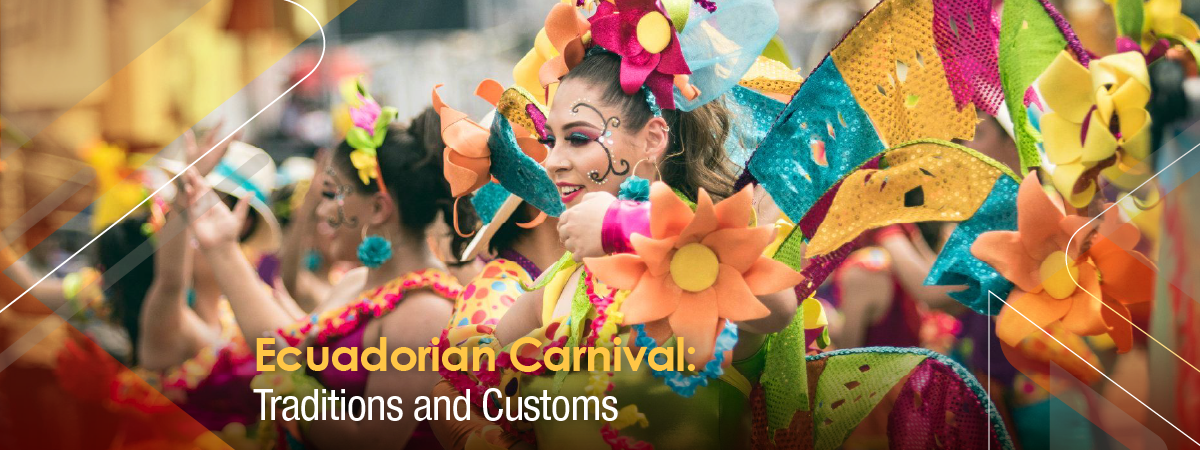
Ecuadorian Carnival: Traditions and Customs
Carnival in Ecuador is a celebration filled with color, music, and unique traditions that vary across regions, showcasing the country’s rich cultural diversity. Many people take advantage of the holiday to travel and enjoy the beautiful beaches along the coast, such as Salinas, Montañita, Manta, Esmeraldas, and Playas, where events, concerts, and recreational activities are organized.
Traditionally, Carnival was celebrated by playing with water, but in recent years, this has changed. Now, carnival foam is more commonly used to avoid wasting water. Meanwhile, in Ambato, in Tungurahua province, Carnival is celebrated differently. In this city, playing with water, flour, eggs, or carnival foam is prohibited. Instead, the locals organize the famous Festival of Fruits and Flowers.
Festival of Flowers and Fruits
This unique festivity begins with the blessing of flowers, fruits, and bread, a Catholic tradition symbolizing gratitude for the region’s agricultural abundance. The church altar is adorned with religious figures crafted from these natural elements, showcasing the deep connection between faith and nature.
The celebrations continue with the “Parade of Brotherhood,” where thousands of young performers from various educational institutions march through the streets with music bands and dance troupes, creating a joyful atmosphere. This colorful event highlights the artistic talent and cultural heritage of the region, as participants wear elaborate costumes inspired by local traditions. Beyond the parade, the festival features a variety of cultural and artistic events, including folk music concerts, theatrical performances, and traditional dance presentations.
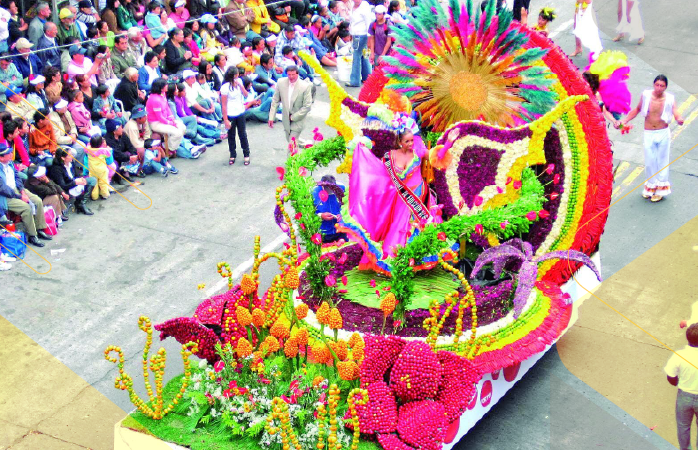
In the Andean region, we have several celebrations that blend pre-Columbian and European traditions, which have been preserved to this day. These festivities reflect the rich cultural heritage of the area and serve as a way to honor both indigenous and colonial influences.
Below are some of the most representative festivities in the highland region:
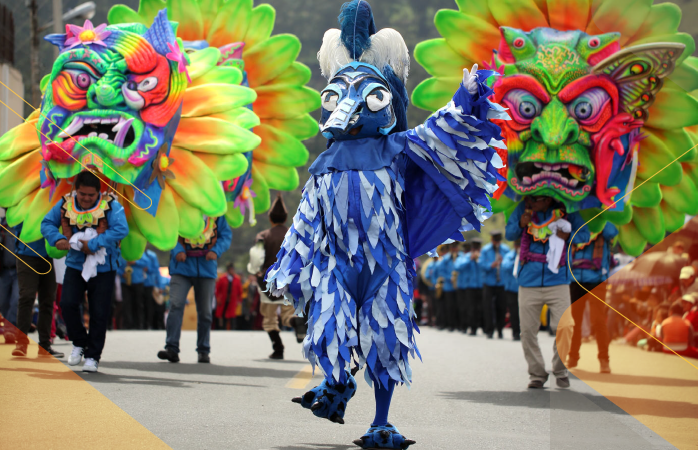
Guaranda Carnival
Located in the Bolívar province, Guaranda’s Carnival is one of the most renowned celebrations in Ecuador. During the main days of the festival, the city comes alive with energetic parades featuring colorful floats, masquerades, and dance bands.
Gastronomy plays a key role in the festivities, offering traditional delicacies such as fritada (fried pork), potatoes with cuy (guinea pig), morcillas (blood sausages), chigüiles (cornmeal and cheese wrapped in leaves), sambo sweets (pumpkin-based treats), chicha (a fermented corn-based beverage), and the famous local liquor “Pájaro Azul.” This festivity is a fusion of ancient indigenous traditions honoring the Cacique (pre-Columbian local leaders) and the land, mixed with European Carnival influences introduced by Spanish colonizers.
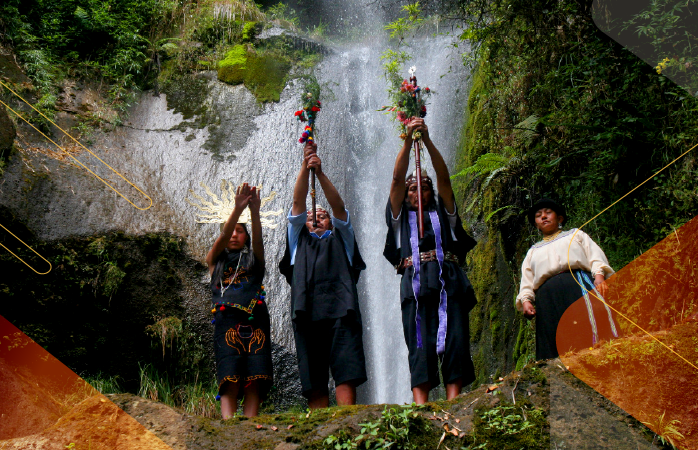
Pawkar Raymi
In Saraguro, Loja province, during Carnival, the Pawkar Raymi is the perfect opportunity to connect with the ancestral traditions of our people and celebrate the blooming of nature. As a Magical Town in southern Ecuador, Saraguro is the ideal setting to experience this festivity, which pays homage to Pachamama (mother earth) with two essential elements: water and flowers.
During the celebration, families gather to enjoy the first harvests of corn, peas, beans, fava beans, lupins, and more, fundamental ingredients of Andean cuisine. The diversity of colors in grains and flowers is reflected in the chacana or Andean cross, a key symbol in the rituals of blessing the products.
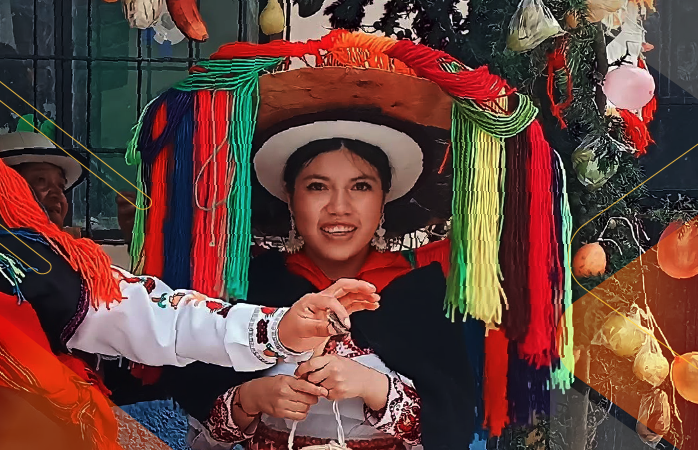
Lalay Raymi
The canton of El Tambo, in Cañar province, is renowned for its ancestral celebrations, with Lalay Raymi standing out as a significant cultural event during Carnival. This festival, deeply rooted in the Cañari tradition, is also known as Pawkar Raymi, the Festival of Blooming and Abundance. It marks a time of renewal, gratitude, and connection with nature.
The Cañari people prepare for the arrival and blessing of Tayta Carnaval, a symbolic figure representing joy and prosperity. During Lalay Raymi, men, women, and children dress in their finest wool garments, adorned with intricate and colorful embroidery, showcasing their artistry and identity. The celebrations take place in Cañari communities, keeping the ancestral spirit alive through rituals, offerings, and festivities that honor fertility, abundance, and the harmony between humans and nature.
These celebrations are just a glimpse of the cultural diversity that defines Carnival in Ecuador. Each region brings its own unique traditions and flavors, making this festivity an unforgettable experience in The Country of Four Worlds.
Let Andean Travel Company take you on an unforgettable journey through Ecuador’s most exciting traditions. Contact us today!
Read also:
